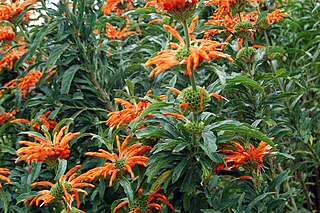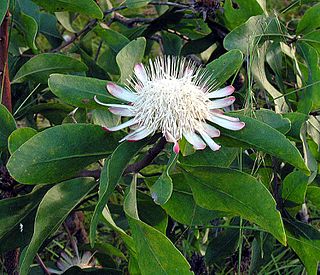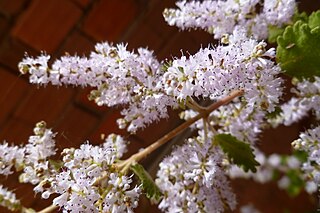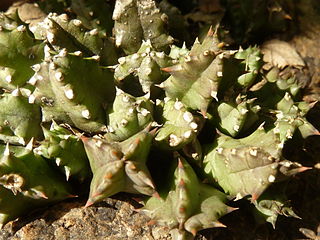Muthi is a traditional medicine practice in Southern Africa as far north as Lake Tanganyika.

Strelitzia reginae, commonly known as the crane flower, bird of paradise, or isigude in Nguni, is a species of flowering plant native to the Cape Provinces and KwaZulu-Natal in South Africa. An evergreen perennial, it is widely cultivated for its dramatic flowers. In temperate areas it is a popular houseplant.

Plectranthus verticillatus, Swedish ivy, Swedish begonia or whorled plectranthus is a plant in the family Lamiaceae (Labiatae), genus Plectranthus. Despite its common name, it is not close to the ivy family of the genus Hedera.

Ipomoea cairica is a vining, herbaceous, perennial plant with palmate leaves and large, showy white to lavender flowers. A species of morning glory, it has many common names, including mile-a-minute vine, Messina creeper, Cairo morning glory, coast morning glory and railroad creeper. The species name cairica translates to "from Cairo", the city where this species was first collected.

Leonotis leonurus, also known as lion's tail and wild dagga, is a plant species in the mint family, Lamiaceae. The plant is a broadleaf evergreen large shrub native to South Africa, where it is very common. It is known for its medicinal properties. The main psychoactive component of Leonotis leonurus is hypothesized to be related to the presence of leonurine or labdanes, Leonotis leonurus has been confirmed to contain Leonurine according to peer reviewed journal published phytochemical analysis. Like other plants in the mint family, it also contains marrubiin. The word "dagga" comes from Afrikaans, and derives in turn from the Khoikhoi "dachab". The word "dagga" has been extended to include cannabis in Afrikaans and South African English, so the use of "wild" serves to distinguish Leonotis leonuris from this.

Protea gaguedi is a species of tree which belongs to the genus Protea.

Agapanthus praecox is a popular garden plant around the world, especially in Mediterranean climates. It is native to the Kwa-Zulu Natal and Western Cape provinces of South Africa. Local names include agapant, bloulelie, isicakathi and ubani. Most of the cultivated plants of the genus Agapanthus are hybrids or cultivars of this species. It is divided into three subspecies: subsp.praecox, subsp. orientalis and subsp. minimus.

Rotheca myricoides is a species of flowering plant in the family Lamiaceae. It is native to Africa and widely cultivated elsewhere. In cultivation, it is frequently known by one of its synonyms, such as Clerodendrum myricoides.

Tulbaghia violacea, commonly known as society garlic, pink agapanthus, wild garlic, sweet garlic, spring bulbs, or spring flowers, is a species of flowering plant in the family Amaryllidaceae, indigenous to southern Africa, and reportedly naturalized in Tanzania and Mexico.

Crassula capitella, is a perennial succulent plant native to southern Africa.

Crassula ovata, commonly known as jade plant, lucky plant, money plant or money tree, is a succulent plant with small pink or white flowers that is native to the KwaZulu-Natal and Eastern Cape provinces of South Africa, and Mozambique; it is common as a houseplant worldwide. Much of its popularity stems from the low levels of care needed; the jade plant requires little water and can survive in most indoor conditions. It is sometimes referred to as the money tree; however, Pachira aquatica also has this nickname.

Crassula nudicaulis is a succulent plant native to South Africa, and Lesotho.

Kalanchoe longiflora, also known as tugela cliff-kalanchoe or long-flower kalanchoe, is a species of the succulent genus Kalanchoe, in the family Crassulaceae. An obscure shrub native to South Africa, it is known for its multi-coloured foliage and yellow flowers, which bloom in autumn to winter.
Eucomis humilis is a species of flowering plant in the family Asparagaceae, subfamily Scilloideae, native to KwaZulu-Natal and Lesotho. It was first described by Baker in 1895. The greenish to purplish flowers appear in summer and are arranged in a spike (raceme), topped by a "head" of green leaflike bracts. Cultivated as an ornamental plant, it can be grown successfully outside where frosts are not too severe.
Eucomis schijffii is a bulbous species of flowering plant in the family Asparagaceae, subfamily Scilloideae, native to the Cape Provinces, KwaZulu-Natal and Lesotho. It was first described by William Frederick Reyneke in 1976. The reddish purple flowers appear in summer and are arranged in a spike (raceme), topped by a "head" of green leaflike bracts. It is cultivated as an ornamental plant and can be grown successfully outside where frosts are not too severe. The smallest of the species of Eucomis, it is particularly suited to being grown in rock gardens or containers.

Tetradenia riparia is a species of flowering plant native to southern Africa. It belongs in the mint and sage family Lamiaceae. It is occasionally referred to as misty plume bush and is commonly used as a decorative garden plant due to its flowers when in full bloom. Tetradenia means 'four glands' and riparia translates to 'growing on banks of rivers'. This species was first described by botanists Hochstetter and Codd in 1983. It is also known as ginger bush, Incense Bush, Ibozane and musk bush.

Drypetes arguta, commonly known as the water ironplum, is a species of small tree or large bush in the family Putranjivaceae. It is native to tropical East Africa. It was first described in 1920 by the English botanist John Hutchinson, who named it Cyclostemon argutus. It was later transferred to the genus Drypetes.

Huernia hystrix, the porcupine huernia, is a species of flowering plant in the family Apocynaceae, native to southeastern Africa. A succulent, it has gained the Royal Horticultural Society's Award of Garden Merit.
Plectranthus ambiguus, the pincushion spurflower, is a species of flowering plant in the family Lamiaceae, native to the Eastern Cape and Kwazulu-Natal provinces of South Africa. Its cultivar 'Manguzuku' has gained the Royal Horticultural Society's Award of Garden Merit. Flowers are pinkish purple with faint purple lines on the upper edge.

Hewittia malabarica is a flowering plant in the monotypic genus HewittiaWight & Arn., belonging to the family Convolvulaceae and widespread throughout tropical Africa, Asia, and Polynesia. It is a climbing or prostrate perennial herb with slender stems and flowers that are pale yellow, cream, or white with a purple center, and large leaves that can be used as a cooked vegetable or used in folk medicine with the roots. The stems can be used to make ropes.























